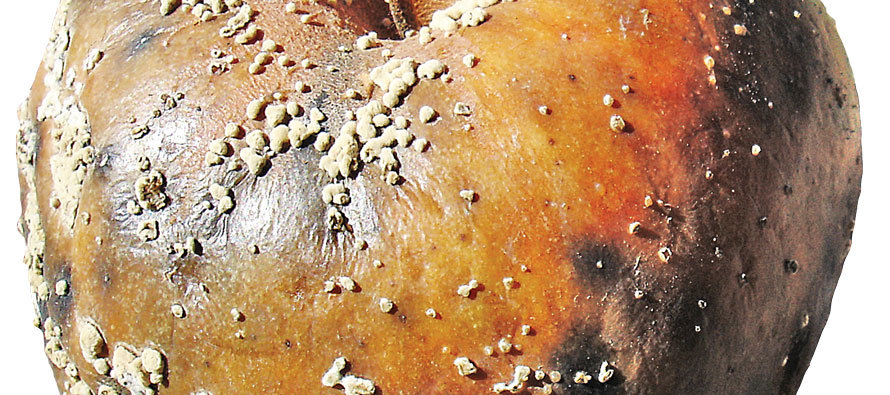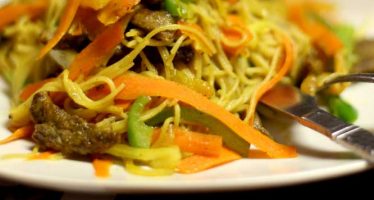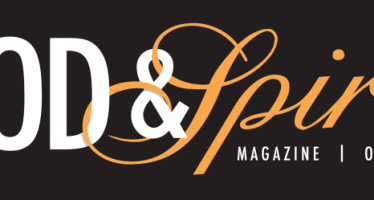The Dumpster: Molding Opinions

Before the dawn of refrigerators, back when humans made ice cubes by banging chunks of glacier against their foreheads, food storage options for leftovers were simpler. You either 1) ate it, 2) it rotted, or 3) it rotted and you ate it anyway. This is how we invented cheese.
Today, milk comes in handy take-home jugs, so it’s hard to remember that at one time the jugs were made of leather and were attached to cows. The next time you are at the grocery store dairy section and you open the cooler door to the bright white array of milk options, try to imagine a row of teats instead.
It is no longer our instinct to reach between a half-ton animal’s legs, grab whatever dangles there, and with a yank squirt what comes out into our mouth. That was probably a dicey idea even then. Drinking cow milk probably started, as most things do, with a fraternity challenge. “I dare you to drink that, Og. Go on! What are you—chicken?”
“Og no chicken!” Og reply in huff. “Og show you!” Og narrowly avoid kick to flat forehead. Og win bet. Hey…Og like milk! Surprise! Og famous.
Not long after Og discovered we could drink cow’s milk, some kid squeezed himself more than he could finish. His mother yelled, “Cows don’t grow on trees, y’know,” which the kid was pretty sure he did know. He couldn’t put the leftover milk in the refrigerator because there wasn’t one yet, and it took the boy only one kick in his flat forehead to learn he couldn’t put milk back in the cow.
So his half-full glass of milk sat on the counter, where it fermented, festered and foamed, until vein-blue tentacles of mold grew over it. By some quirk of fate, a little bit of rennet drooled into the mix. Rennet is a nice word for stomach mucus. It is beyond me to guess how stomach fluid got into his milk—one can only suppose the boy was under sixteen. The mother, to get rid of the growing stink, moved the festering blob of coagulating milk-fur into a nearby cave, where it continued cheerfully to rot.
The furry milk continued to clot in the cave, and in a fit of starvation—or upon another frat-boy dare—someone took a bite of it. To everyone’s astonishment, he did not die.
Any food that you could leave out for weeks and still eat was a valuable commodity—just ask the guys who make Twinkies. Nonetheless, furry, rotten food is hard to sell, something Og learned when he tried to pawn off his dead cat as a hat.
The live mold that makes bleu cheese blue is brevibacterium livens, the same bacteria that makes your feet stink, which should come as no surprise. Og couldn’t call his new invention “toe cheese” because that name was already taken. He went with “bleu cheese” because things seem fancier when they stink in French.
Sauerkraut was discovered pretty much the same way as cheese. There was always a lot of leftover cabbage, because, well, it tasted like cabbage. Like the bleu cheese, it too sat and fermented in its own mold and bacteria until someone got so hungry—or his frat brother taunted—that he took a bite, and decided it tasted better than starvation. Because Germans name things literally—volks wagen = family car, sauer kraut = rotten cabbage—it grew popular only among the Germans. The rest of us might have tried sauerkraut sooner had they named it bleu chou.
The importance of attractive food labeling is especially evident in Korea, where traditional dim sum delicacies include “White Cloud Phoenix Talons,” which don’t sell as well when you call them by their German name, “Steamed Little Chicken Toes.” An exception is the recent rise of yogurt sales, with the fanciest brands baldly bragging about “Live, active cultures!” So far this has only worked with yogurt, a food we already expect to be bad. The beef industry, by comparison, has yet to figure out how to sell meat with the slogan, “Crawling with live, active bacteria!”
Today, Americans prefer their food mold-free, made under the most sterile conditions. Pasteurized, wrapped in tamper-proof safety foil, vacuum-sealed, boxed, shrink-wrapped and refrigerated, American cheese is aptly named. We like the packaging of American cheese because it keeps mold out. The French like our packaging because it keeps our cheese in.

Michael Campbell
Michael Campbell is a songwriter and humor essayist. His “Dumpster” column closes every issue of Food & Spirits magazine. He has authored two books, including Are You Going To Eat That? (2009), and Of Mice and Me (2017). He also has four albums of original songs. The latest, My Turn Now, was released in 2015. Learn more at michaelcampbellsongwriter.com.
Related Articles
Supper Club: Chaima’s African Cuisine
The Supper Club is a part of Metropolitan Community College’s TriOmega Chapter at the Institute for the Culinary Arts. Each
Letter From the Publisher: Issue 17
Welcome to the latest issue of Food & Spirits Magazine. This issue of FSM is the ‘Cocktail Issue’, and as
Bar Chat: The Intoxicologist
I first met Cheri Loughlin (a.k.a. The Intoxicologist) a few years ago at a cocktails class we both attended. At
No comments
Write a commentOnly registered users can comment.














